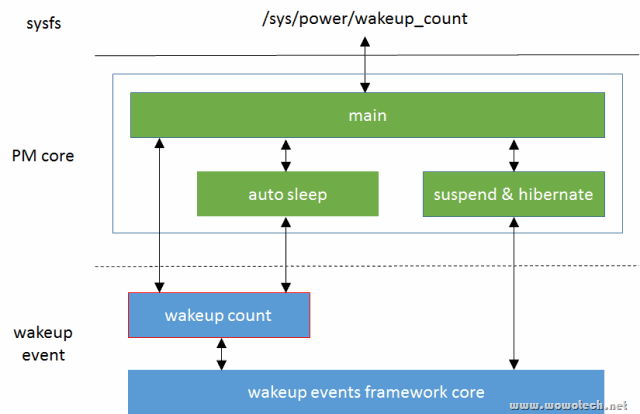Linux电源管理(8)_Wakeup count功能
2015-09-21 09:54
567 查看
from : http://www.wowotech.net/pm_subsystem/wakeup_count.html
PM之Suspend功能”和“Linux电源管理(7)_Wakeup events framework”两篇文章,分析wakeup count的功能、实现逻辑、背后的思考,同时也是对这两篇文章的复习和总结。

1)任何想发起电源状态切换的实体(可以是用户空间电源管理进程,也可以是内核线程,简称C),在发起状态切换前,读取系统的wakeup counts(该值记录了当前的wakeup event总数),并将读取的counts告知wakeup events framework。
2)wakeup events framework记录该counts到一个全局变量中(saved_count)。
3)随后C发起电源状态切换(如STR),执行suspend过程。
4)在suspend的过程中,wakeup events framework照旧工作(直到系统中断被关闭),上报wakeup events,增加wakeup events counts。
5)suspend执行的一些时间点(可参考“Linux电源管理(6)_Generic PM之Suspend功能”),会调用wakeup events framework提供的接口(pm_wakeup_pending),检查是否有wakeup没有处理。
6)检查逻辑很简单,就是比较当前的wakeup counts和saved wakeup counts(C发起电源状态切换时的counts),如果不同,就要终止suspend过程。
在进行代码分析之前,我们先用伪代码的形式,写出一个利用wakeup count进行suspend操作的例子,然后基于该例子,分析相关的实现。
例子很简单:
a)读取wakeup count值,如果成功,将读取的值回写。否则说明有正在处理的wakeup events,continue。
b)回写后,判断返回值是否成功,如果不成功(说明读、写的过程中产生了wakeup events),继续读、写,直到成功。成功后,可以触发电源状态切换。
4.2 /sys/power/wakeup_count
wakeup_count文件是在kernel/power/main.c中,利用power_attr注册的,如下(大家可以仔细研读一下那一大段注释,内核很多注释写的非常好,而好的注释,就是软件功力的体现):
实现很简单:read时,直接调用pm_get_wakeup_count(注意第2个参数);write时,直接调用pm_save_wakeup_count(注意用户空间的wakeup count功能和auto sleep互斥,会在下篇文章解释原因)。这两个接口均是wakeup events framework提供的接口,跟着代码往下看吧。
4.3 pm_get_wakeup_count
pm_get_wakeup_count的实现如下:
该接口有两个参数,一个是保存返回的count值得指针,另一个指示是否block,具体请参考代码逻辑:
a)如果block为false,直接读取registered wakeup events和wakeup events in progress两个counter值,将registered wakeup events交给第一个参数,并返回wakeup events in progress的状态(若返回false,说明当前有wakeup events正在处理,不适合suspend)。
b)如果block为true,定义一个等待队列,等待wakeup events in progress为0,再返回counter。
注1:由4.2小节可知,sysfs发起的read动作,block为true,所以如果有正在处理的wakeup events,read进程会阻塞。其它模块(如auto sleep)发起的read,则可能不需要阻塞。
4.4 pm_save_wakeup_count
pm_save_wakeup_count的实现如下:
1)注意这个变量,events_check_enabled,如果它不为真,pm_wakeup_pending接口直接返回false,意味着如果不利用wakeup count功能,suspend过程中不会做任何wakeup events检查,也就不会进行任何的同步。
2)解除当前的registered wakeup events、wakeup events in progress,保存在变量cnt和inpr中。
3)如果写入的值和cnt不同(说明读、写的过程中产生events),或者inpr不为零(说明有events正在被处理),返回false(说明此时不宜suspend)。
4)否则,events_check_enabled置位(后续的pm_wakeup_pending才会干活),返回true(可以suspend),并将当前的wakeup count保存在saved count变量中。
4.5 /sys/power/state
再回忆一下“Linux电源管理(6)_Generic PM之Suspend功能”中suspend的流程,在suspend_enter接口中,suspend前的最后一刻,会调用pm_wakeup_pending接口,代码如下:
在write wakeup_count到调用pm_wakeup_pending这一段时间内,wakeup events framework会照常产生wakeup events,因此如果pending返回true,则不能“enter”,终止suspend吧!
注2:wakeup后,会清除events_check_enabled标记。
“Linux电源管理(7)_Wakeup events framework”中已经介绍过pm_wakeup_pending了,让我们再看一遍吧:
a)首先会判断events_check_enabled是否有效,无效直接返回false。有效的话:
b)获得cnt和inpr,如果cnt不等于saved_count(说明这段时间内有events产生),或者inpr不为0(说明有events正在被处理),返回true(告诉调用者,放弃吧,时机不到)。同时清除events_check_enabled的状态。
c)否则,返回false(放心睡吧),同时保持events_check_enabled的置位状态(以免pm_wakeup_pending再次调用)。
Okay,结束了,等待wakeup吧~~~~
1. 前言
Wakeup count是Wakeup events framework的组成部分,用于解决“system suspend和system wakeup events之间的同步问题”。本文将结合“Linux电源管理(6)_GenericPM之Suspend功能”和“Linux电源管理(7)_Wakeup events framework”两篇文章,分析wakeup count的功能、实现逻辑、背后的思考,同时也是对这两篇文章的复习和总结。
2. wakeup count在电源管理中的位置
wakeup count的实现位于wakeup events framework中(drivers/base/power/wakeup.c),主要为两个模块提供接口:通过PM core向用户空间提供sysfs接口;直接向autosleep(请参考下一篇文章)提供接口。
3. wakeup count的功能
wakeup count的功能是suspend同步,实现思路是这样的:1)任何想发起电源状态切换的实体(可以是用户空间电源管理进程,也可以是内核线程,简称C),在发起状态切换前,读取系统的wakeup counts(该值记录了当前的wakeup event总数),并将读取的counts告知wakeup events framework。
2)wakeup events framework记录该counts到一个全局变量中(saved_count)。
3)随后C发起电源状态切换(如STR),执行suspend过程。
4)在suspend的过程中,wakeup events framework照旧工作(直到系统中断被关闭),上报wakeup events,增加wakeup events counts。
5)suspend执行的一些时间点(可参考“Linux电源管理(6)_Generic PM之Suspend功能”),会调用wakeup events framework提供的接口(pm_wakeup_pending),检查是否有wakeup没有处理。
6)检查逻辑很简单,就是比较当前的wakeup counts和saved wakeup counts(C发起电源状态切换时的counts),如果不同,就要终止suspend过程。
4. wakeup count的实现逻辑
4.1 一个例子在进行代码分析之前,我们先用伪代码的形式,写出一个利用wakeup count进行suspend操作的例子,然后基于该例子,分析相关的实现。
1: do {2: ret = read(&cnt, "/sys/power/wakeup_count");
3: if (ret) {4: ret = write(cnt, "/sys/power/wakeup_count");
5: } else {6: countine;
7: }
8: } while (!ret);
9:
10: write("mem", "/sys/power/state");11:
12: /* goto here after wakeup */
例子很简单:
a)读取wakeup count值,如果成功,将读取的值回写。否则说明有正在处理的wakeup events,continue。
b)回写后,判断返回值是否成功,如果不成功(说明读、写的过程中产生了wakeup events),继续读、写,直到成功。成功后,可以触发电源状态切换。
4.2 /sys/power/wakeup_count
wakeup_count文件是在kernel/power/main.c中,利用power_attr注册的,如下(大家可以仔细研读一下那一大段注释,内核很多注释写的非常好,而好的注释,就是软件功力的体现):
1: /*
2: * The 'wakeup_count' attribute, along with the functions defined in
3: * drivers/base/power/wakeup.c, provides a means by which wakeup events can be
4: * handled in a non-racy way.
5: *
6: * If a wakeup event occurs when the system is in a sleep state, it simply is
7: * woken up. In turn, if an event that would wake the system up from a sleep
8: * state occurs when it is undergoing a transition to that sleep state, the
9: * transition should be aborted. Moreover, if such an event occurs when the
10: * system is in the working state, an attempt to start a transition to the
11: * given sleep state should fail during certain period after the detection of
12: * the event. Using the 'state' attribute alone is not sufficient to satisfy
13: * these requirements, because a wakeup event may occur exactly when 'state'
14: * is being written to and may be delivered to user space right before it is
15: * frozen, so the event will remain only partially processed until the system is
16: * woken up by another event. In particular, it won't cause the transition to
17: * a sleep state to be aborted.
18: *
19: * This difficulty may be overcome if user space uses 'wakeup_count' before
20: * writing to 'state'. It first should read from 'wakeup_count' and store
21: * the read value. Then, after carrying out its own preparations for the system
22: * transition to a sleep state, it should write the stored value to
23: * 'wakeup_count'. If that fails, at least one wakeup event has occurred since
24: * 'wakeup_count' was read and 'state' should not be written to. Otherwise, it
25: * is allowed to write to 'state', but the transition will be aborted if there
26: * are any wakeup events detected after 'wakeup_count' was written to.
27: */
28:
29: static ssize_t wakeup_count_show(struct kobject *kobj,
30: struct kobj_attribute *attr,
31: char *buf)
32: {33: unsigned int val;
34:
35: return pm_get_wakeup_count(&val, true) ?
36: sprintf(buf, "%u\n", val) : -EINTR;
37: }
38:
39: static ssize_t wakeup_count_store(struct kobject *kobj,
40: struct kobj_attribute *attr,
41: const char *buf, size_t n)
42: {43: unsigned int val;
44: int error;
45:
46: error = pm_autosleep_lock();
47: if (error)
48: return error;
49:
50: if (pm_autosleep_state() > PM_SUSPEND_ON) {51: error = -EBUSY;
52: goto out;
53: }
54:
55: error = -EINVAL;
56: if (sscanf(buf, "%u", &val) == 1) {57: if (pm_save_wakeup_count(val))
58: error = n;
59: }
60:
61: out:
62: pm_autosleep_unlock();
63: return error;
64: }
65:
66: tr(wakeup_count);
实现很简单:read时,直接调用pm_get_wakeup_count(注意第2个参数);write时,直接调用pm_save_wakeup_count(注意用户空间的wakeup count功能和auto sleep互斥,会在下篇文章解释原因)。这两个接口均是wakeup events framework提供的接口,跟着代码往下看吧。
4.3 pm_get_wakeup_count
pm_get_wakeup_count的实现如下:
1: bool pm_get_wakeup_count(unsigned int *count, bool block)
2: {3: unsigned int cnt, inpr;
4:
5: if (block) {6: DEFINE_WAIT(wait);
7:
8: for (;;) {9: prepare_to_wait(&wakeup_count_wait_queue, &wait,
10: TASK_INTERRUPTIBLE);
11: split_counters(&cnt, &inpr);
12: if (inpr == 0 || signal_pending(current))
13: break;
14:
15: schedule();
16: }
17: finish_wait(&wakeup_count_wait_queue, &wait);
18: }
19:
20: split_counters(&cnt, &inpr);
21: *count = cnt;
22: return !inpr;
23: }
该接口有两个参数,一个是保存返回的count值得指针,另一个指示是否block,具体请参考代码逻辑:
a)如果block为false,直接读取registered wakeup events和wakeup events in progress两个counter值,将registered wakeup events交给第一个参数,并返回wakeup events in progress的状态(若返回false,说明当前有wakeup events正在处理,不适合suspend)。
b)如果block为true,定义一个等待队列,等待wakeup events in progress为0,再返回counter。
注1:由4.2小节可知,sysfs发起的read动作,block为true,所以如果有正在处理的wakeup events,read进程会阻塞。其它模块(如auto sleep)发起的read,则可能不需要阻塞。
4.4 pm_save_wakeup_count
pm_save_wakeup_count的实现如下:
1: bool pm_save_wakeup_count(unsigned int count)
2: {3: unsigned int cnt, inpr;
4: unsigned long flags;
5:
6: events_check_enabled = false;
7: spin_lock_irqsave(&events_lock, flags);
8: split_counters(&cnt, &inpr);
9: if (cnt == count && inpr == 0) {10: saved_count = count;
11: events_check_enabled = true;
12: }
13: spin_unlock_irqrestore(&events_lock, flags);
14: return events_check_enabled;
15: }
1)注意这个变量,events_check_enabled,如果它不为真,pm_wakeup_pending接口直接返回false,意味着如果不利用wakeup count功能,suspend过程中不会做任何wakeup events检查,也就不会进行任何的同步。
2)解除当前的registered wakeup events、wakeup events in progress,保存在变量cnt和inpr中。
3)如果写入的值和cnt不同(说明读、写的过程中产生events),或者inpr不为零(说明有events正在被处理),返回false(说明此时不宜suspend)。
4)否则,events_check_enabled置位(后续的pm_wakeup_pending才会干活),返回true(可以suspend),并将当前的wakeup count保存在saved count变量中。
4.5 /sys/power/state
再回忆一下“Linux电源管理(6)_Generic PM之Suspend功能”中suspend的流程,在suspend_enter接口中,suspend前的最后一刻,会调用pm_wakeup_pending接口,代码如下:
1: static int suspend_enter(suspend_state_t state, bool *wakeup)
2: {3: ...
4: error = syscore_suspend();
5: if (!error) {6: *wakeup = pm_wakeup_pending();
7: if (!(suspend_test(TEST_CORE) || *wakeup)) {8: error = suspend_ops->enter(state);
9: events_check_enabled = false;
10: }
11: syscore_resume();
12: }
13: ...
14: }
在write wakeup_count到调用pm_wakeup_pending这一段时间内,wakeup events framework会照常产生wakeup events,因此如果pending返回true,则不能“enter”,终止suspend吧!
注2:wakeup后,会清除events_check_enabled标记。
“Linux电源管理(7)_Wakeup events framework”中已经介绍过pm_wakeup_pending了,让我们再看一遍吧:
1: bool pm_wakeup_pending(void)
2: {3: unsigned long flags;
4: bool ret = false;
5:
6: spin_lock_irqsave(&events_lock, flags);
7: if (events_check_enabled) {8: unsigned int cnt, inpr;
9:
10: split_counters(&cnt, &inpr);
11: ret = (cnt != saved_count || inpr > 0);
12: events_check_enabled = !ret;
13: }
14: spin_unlock_irqrestore(&events_lock, flags);
15:
16: if (ret)
17: print_active_wakeup_sources();
18:
19: return ret;
20: }
a)首先会判断events_check_enabled是否有效,无效直接返回false。有效的话:
b)获得cnt和inpr,如果cnt不等于saved_count(说明这段时间内有events产生),或者inpr不为0(说明有events正在被处理),返回true(告诉调用者,放弃吧,时机不到)。同时清除events_check_enabled的状态。
c)否则,返回false(放心睡吧),同时保持events_check_enabled的置位状态(以免pm_wakeup_pending再次调用)。
Okay,结束了,等待wakeup吧~~~~
相关文章推荐
- Linux电源管理(7)_Wakeup events framework
- Linux系统函数execve说明(02)---实现两个程序之间的调用
- Linux学习记录(11)LVM的基本概念和操作
- Linux下的一些I/O统计工具
- linux ssh 使用深度解析(key登录详解)
- svn: E200033: database is locked解决办法
- Linux 部署ASP.NET SQLite 应用 的坎坷之旅 附demo及源码
- Linux 删除文件夹命令
- Linux常用命令大全
- 手把手教你Linux服务器集群部署.net网站 - 让MVC网站运行起来
- Linux实现时钟中断的全过程
- Linux查看系统配置常用命令
- Linux目录解释
- Linux系统函数execve说明(01)---函数参数说明
- Linux与windows的对比
- 在win7系统的电脑上安装CentOS7双系统
- linux0.11下的中断机制分析
- 【Linux探索之旅】第三部分测验题
- 【Linux探索之旅】第三部分测验题
- 【Linux探索之旅】第三部分第五课:延时执行,唯慢不破
